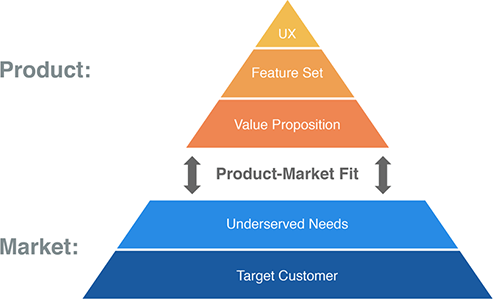
- Software Development
If you are part of the universe of startups or digital products, you’ve certainly heard of it. The Product-Market Fit is a great indicator of the success of a product, as it concerns the interaction among three pillars: the business, the product, and the consumers.
For Marc Andreessen, entrepreneur and investor known for the popularization of the term, Product-Market Fit means finding a good market and developing a product capable of satisfying it. Sounds simple, right? The truth is that convincing the target customer of a digital product to buy it, use it and share it – on a scale sufficient to ensure business growth and profitability – is no easy task.
Therefore, in this article, we will share some tips to achieve the Product-Market Fit, in addition to highlighting important details so that you can assess whether it has really been achieved. Let’s go!
In the book Four Steps to Epiphany, Steve Blank defines Product-Market Fit as the process in which you find a group of customers and a market that react positively to your product: you solve a problem and you get paid for it. According to the entrepreneur, you need to find “the perfect fit” between product and consumers; either creating the product and then reaching out to consumers, or finding the consumers and then developing the product.
Dan Olsen contributes to this vision through his Product-Market Fit Pyramid. According to Product Management, the base of the pyramid is the target customer, and just above are their underserved needs. These two layers form the market. The top three layers relate to the product, respectively being value proposition – what target customer needs you will meet and how will you do it differently from your competitors; The feature set – which features your product will have; and the user experience – how the target customer will interact with your product.

Source: https://www.mindtheproduct.com/the-playbook-for-achieving-product-market-fit/
In this model, the product-market fit relates to how much the assumptions and decisions of the three upper layers resonate with the two lower layers. Therefore, the five layers must be solid and well-defined.
The two definitions above indicate that the Product-Market Fit is directly related to the hypothesis validation. In this sense, we cannot forget to approach the MVP idea, presented by entrepreneur Eric Ries in the book The Lean Startup. The Minimum Viable Product is the first version of a hypothesis for a new product, which after being released to the market, will be developed to reach the desired state, or will be abandoned if users do not use it – or consider it useless.
With a broader view, we have the definition of Aaron Walter, author of the book Principles of Product Design. For the Product Lead, Product-Market Fit refers to the sharing of the product among users. This means their experience is so good that they recommend the product to others. In Walter’s words, “suddenly your customers become your salespeople.”
This idea corroborates Andreessen’s belief that to invest in any business, proof of Product-Market Fit is required. Therefore, he divides the life cycle of startups in before product-market fit (BPMF) and after product-market fit (APMF). According to the entrepreneur, developing a product without first determining that it has enough market to sustain itself and generate profit is counterproductive.
It is important to point out that the duty to achieve the adjustment of the product to the market is not only of Product Managers and Product Marketing Managers: the entire team involved with the product must share this commitment, from developers, testers, and designers up to salespeople.
This means that everyone should be aware of their role and how challenging this journey can be. After all, achieving Product-Market Fit is not about constant, linear growth, but about analyzing evidence, whether positive or negative, to make decisions.
According to the entrepreneur Ryan Holiday “Product-Market Fit is not a mythical status that happens accidentally. Companies work for this; they crawl towards it and are ready to throw away weeks or months of work because the evidence supports this decision.”
Of course, there is no magic formula for achieving product-market fit, but Olsen, in the book The Lean Product Playbook, offers a high-level path that can indicate the main steps:
To carry out the last four steps, it is a good idea to rely on the Business Model Canvas and on Alex Osterwalder’s latest framework, Testing Business Ideas. Through them, it is possible to identify and test business models in order to define the value proposition, customer segment, relationship, and channel of a digital product.
Such tests can be performed with No-Code and Low-Code MVPs, which reduces development time and minimizes risk. Through these methods, it is possible to discover whether the direction we envision makes sense (Discovery) and validate whether the chosen product paths have evidence of success (Validation).
We have already written about product metrics here on the blog. Frameworks such as KPIs, OKRs, NSM, Pirate Metrics, and Sales Funnel are some options that can be used to track digital product data and evaluate its performance.
But what data are these? Key metrics for new products are CAC, LTV, CTR, CVR, and CR. They indicate how much you are investing to acquire each customer; what the lifetime value of each user is; what the click-through rate, the conversion rate, and the abandonment rate of your digital product are.
With such data in hand, and applying user surveys, try to answer the following questions:
These questions will indicate whether your team is on the right path in pursuit of the Product-Market Fit. Making small changes on an ongoing basis, as you gather feedback, makes customers begin to understand the value of your product and begin to share their positive experiences with other users.
At SoftDesign, we work with the Conception and Experimentation of new digital products. The Production Conception service allows you to elaborate the idea of the product or service, define your target customer and your value proposition, and plan strategically. The Experimentation service, on the other hand, allows a No-Code or Low-Code MVP to be developed to test hypotheses and adapt the product to the market. With the success of these steps, moving towards Development becomes safer and more economical.
To understand better, fill in the form below so we can talk to you about your needs:
Experience having a reliable partner to your IT challenges. Let’s talk about our unique approach to discover and deliver outstanding solutions.

